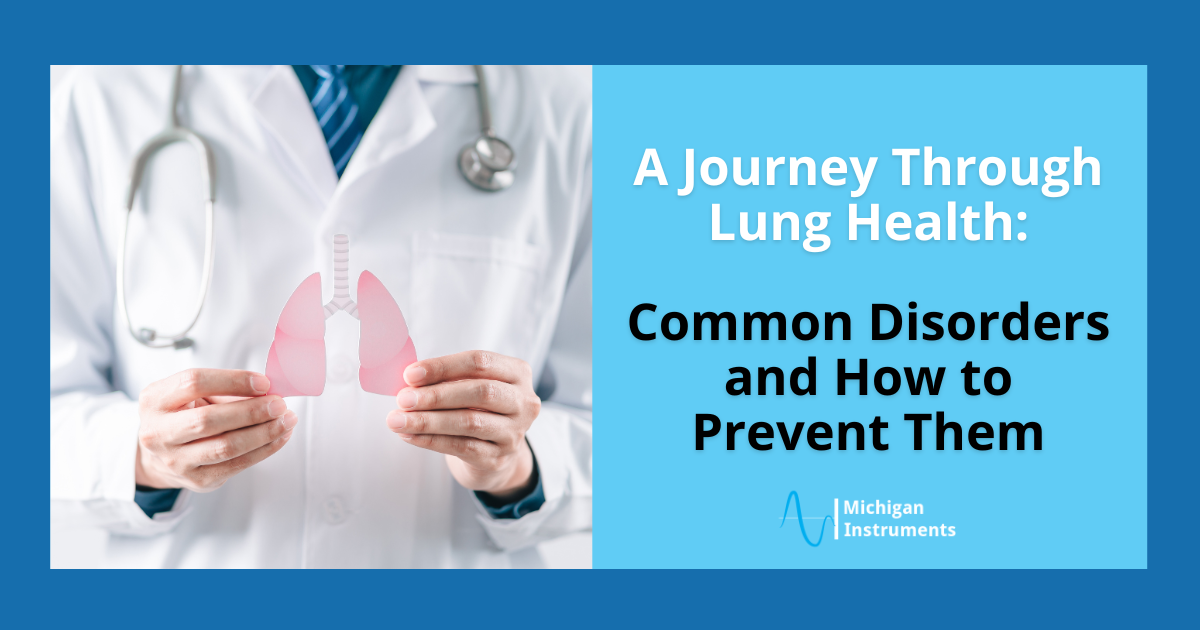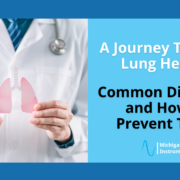
The lungs are undoubtedly one of the most important organs in the human body. They play a vital role in our overall health and well-being while serving as the gateway for oxygen intake and the removal of carbon dioxide. Their function is essential to sustaining life itself.
Beyond that, the lungs actively participate in immune defense, support physical activity, and contribute to the overall balance of the body’s systems. Understanding the significance of lung health and function goes beyond breathing; it supports our capacity to thrive and maintain optimal health.
Keep reading to know more about the importance of lung health and how to prevent lung disease.
The Importance of Lung Health and Function
In this blog, we’ll take a closer look at the importance of lung health and function. We’ll explore how these critical organs impact every aspect of our lives, and why nurturing them is essential for our longevity and quality of life.
Maintaining optimal lung health is crucial for several reasons:
1. Oxygenation of the Body
The primary function of the lungs is to supply oxygen to the bloodstream and remove carbon dioxide. Adequate oxygenation is essential to ensure proper function of all your organs.
Without oxygenation, cells can’t perform their functions, which leads to inadequate overall health.
2. Respiration
Breathing is an involuntary action controlled by the respiratory system. Your lungs expand and contract with each breath, allowing air to flow in and out of the body.
Efficient respiration ensures that oxygen is delivered to tissues and organs and waste gasses are eliminated, supporting metabolic processes and maintaining a healthy pH balance.
3. Immune Defense
Did you know that your respiratory system plays a crucial role in defending the body against pathogens, pollutants, and foreign particles?
It’s true; mucus and cilia in the airways trap and remove harmful substances. Immune cells in the lungs detect and neutralize invading microorganisms, helping to prevent infections and maintain your respiratory health.
4. Physical Activity and Endurance
Healthy lungs allow you to engage in physical activities and exercise without experiencing fatigue or shortness of breath. Strong respiratory muscles and efficient breathing gives you endurance and stamina to lead an active and fulfilling life.
5. Overall Health and Well-being
Lung health is closely linked to overall health and well-being. Chronic lung conditions such as COPD, asthma, and lung cancer can significantly impact your quality of life. These conditions can lead to symptoms such as coughing, wheezing, and difficulty breathing. Maintaining optimal lung function is essential for preserving physical and mental health and enjoying a high quality of life.
It’s clear that lungs are vital for sustaining life, supporting physical activity, and protecting against respiratory illnesses and diseases. By taking proactive steps to maintain respiratory health, you can enhance your overall well-being and enjoy a higher quality of life.
Understanding Lung Diseases
Learning how to prevent lung disease starts with understanding some of the most common ones. Human lungs are susceptible to various diseases that can impact our quality of life. Let’s explore the 7 most common lung conditions and discuss strategies to prevent them.
Chronic Obstructive Pulmonary Disease (COPD)
COPD is a progressive lung disease characterized by obstructed airflow, making it difficult to breathe. It encompasses conditions such as chronic bronchitis and emphysema, often caused by long-term exposure to irritants like cigarette smoke or air pollution.
Symptoms include coughing, wheezing, and shortness of breath, which can significantly impact daily activities and quality of life.
Asthma
Asthma is a chronic respiratory condition characterized by inflammation and narrowing of the airways, leading to recurrent episodes of wheezing, coughing, chest tightness, and shortness of breath.
Daily triggers such as allergens, respiratory infections, and environmental factors can make symptoms worse, making it essential for individuals with asthma to manage their condition effectively.
Lung Cancer
Lung cancer is one of the most common yet deadliest forms of cancer worldwide. It is often linked to smoking, subjection to secondhand smoke, and exposure to carcinogens like asbestos and radon.
Early cancer detection through screenings plus adopting a healthier lifestyle can improve outcomes and increase survival rates for those diagnosed with lung cancer.
Pneumonia
Pneumonia is an infection that inflames the air sacs in one or both lungs, causing them to fill with fluid or pus. It can be caused by bacteria, viruses, or fungi and is characterized by symptoms such as fever, chills, cough, and difficulty breathing.
Pneumonia can range from mild to severe and may require hospitalization, particularly in vulnerable populations such as the elderly and individuals with weakened immune systems.
Pulmonary Fibrosis
Pulmonary fibrosis is a progressive lung disease characterized by scarring of the lung tissue, which makes it difficult for the lungs to function properly. While the exact cause is often unknown, factors such as exposure to environmental toxins, certain medications, and autoimmune diseases may contribute to its development.
Symptoms include shortness of breath, dry cough, fatigue, and unexplained weight loss, with treatment aimed at managing symptoms and slowing disease progression.
Bronchiectasis
Bronchiectasis is a chronic condition characterized by permanent enlargement of the airways in the lungs, leading to recurrent infections and inflammation. It can occur alongside conditions such as cystic fibrosis, respiratory infections, or inhaling toxic substances.
Symptoms include persistent cough, excess mucus production, and frequent respiratory infections, with treatment focusing on clearing airway secretions, managing infections, and preventing complications.
Pulmonary Embolism
A pulmonary embolism occurs when a blood clot travels to the lungs and blocks blood flow, leading to potentially life-threatening consequences. Risk factors include immobility, surgery, pregnancy, and certain medical conditions such as cancer and thrombophilia.
Symptoms can vary but may include sudden onset of chest pain, shortness of breath, rapid heart rate, and coughing up blood. Prompt medical attention is essential to prevent complications and improve outcomes for individuals with pulmonary embolism.
Preventing Lung Diseases
The lung diseases outlined above can lead to decreased quality of life and even death. It’s important to care for our lungs to lead a healthy, fulfilling life.
While some lung diseases are unavoidable due to environmental factors or because of other diseases, preventing most lung diseases is possible by leading a healthy life.
Here are some ways to prevent these lung diseases.
1. Avoid Tobacco Smoke
Tobacco smoke is a leading cause of lung disease and cancer. If you smoke, quitting is the single most important step you can take to protect your lung health.
Avoid exposure to secondhand smoke and encourage others to do the same, especially around children and individuals with respiratory conditions.
2. Maintain a Healthy Lifestyle
Eating a balanced diet rich in fruits, vegetables, and whole grains can support lung health by providing essential nutrients and antioxidants. Regular exercise strengthens the respiratory muscles and improves lung function, reducing the risk of lung disease and promoting overall well-being.
3. Minimize Exposure to Air Pollutants
Indoor and outdoor air pollutants, such as particulate matter, ozone, and nitrogen dioxide, can contribute to respiratory problems and worsen existing lung conditions. Take steps to minimize exposure by using air purifiers, avoiding outdoor activities during high pollution days, and advocating for clean air policies in your community.
4. Practice Good Hygiene
Practicing good hygiene , such as washing hands frequently, covering coughs and sneezes, and staying home when sick, can help prevent the spread of respiratory infections like influenza and COVID-19.
Additionally, getting vaccinated against preventable respiratory illnesses can provide added protection for yourself and those around you.
Safeguarding Our Lungs is Key to Optimal Health
The importance of good lung health and function cannot be overstated. From the oxygenation of our bodies to immune defense and physical endurance, our lungs are indispensable to our well-being.
By understanding the common conditions that can affect lung health and adopting preventive measures, we can safeguard these vital organs and enhance our overall quality of life.
Whether it’s avoiding tobacco smoke, maintaining a healthy lifestyle, or practicing good respiratory hygiene, every action we take contributes to the health and longevity of our lungs.
Join Michigan Instruments in prioritizing lung health, not only for ourselves but for future generations, ensuring that we can continue to breathe easy and thrive in the years to come.
Exploring Lung Health Innovations with Michigan Instruments
At Michigan Instruments, we’re committed to advancing respiratory care. Our TTL and PneuView Lung Simulators serve as indispensable tools in the realm of medical research and development. These simulators offer realistic and precise simulation capabilities, providing engineers with a safe and controlled environment to design and test therapeutic and monitoring devices.
Our commitment to respiratory research and care isn’t solely for human use: In a 2018 collaboration with a veterinary facility, we embarked on a unique project to simulate dolphins under anesthesia.
By developing and testing a specialized solution tailored to their needs, we helped ensure the safety and efficacy of their dolphin ventilator for medical use.
The Future of Lung Health Begins Here
With options for setup, accuracy, reliability, and durability, our lung simulators empower researchers to achieve consistent settings and repeatable results. The integration of PneuView software further enhances the capabilities of our simulators, allowing R&D professionals to access real-time data collection for documentation, review, and analysis.
Our fully calibrated lung simulators are available in single or dual-lung models for both adults and infants, offering researchers the flexibility to explore a wide range of healthy and diseased lung conditions.
Additionally, our Spontaneous Breathing Lungs enable the simulation of natural breathing patterns, enhancing the realism of research scenarios.
Request a quote for our different devices including the lung simulation products or mechanical CPR devices (Thumper & Life-Stat).




